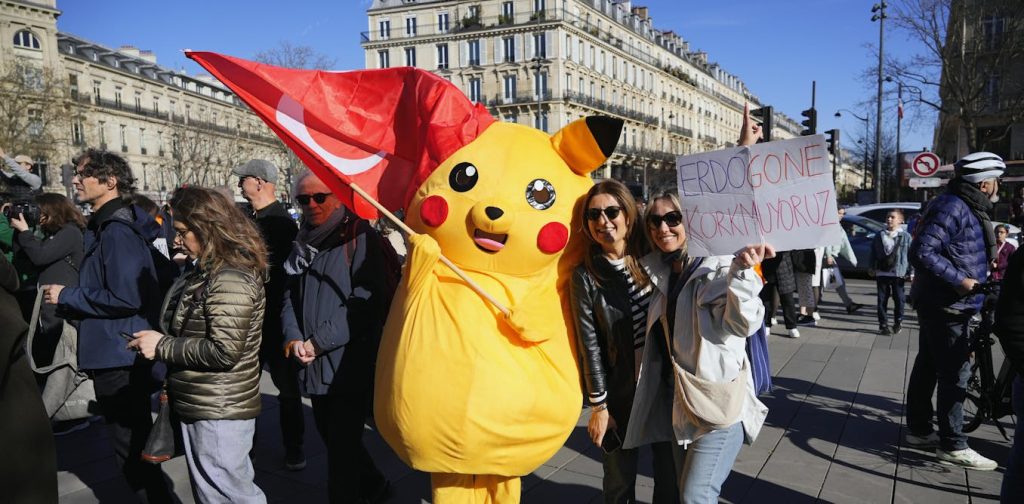Listen to the article
In an unusual twist to recent political demonstrations in Turkey, a protester dressed as Pikachu, the beloved yellow Pokémon character, joined crowds opposing the country’s authoritarian leadership last week. The striking image quickly spread across social media platforms, followed by the emergence of a digitally manipulated version that created confusion about which visuals were authentic.
This incident represents a growing trend of AI-generated or AI-edited imagery circulating during breaking news events, challenging viewers’ ability to distinguish between genuine documentation and synthetic content.
The appearance of the costumed demonstrator amid the serious political protests created a stark visual contrast that captured widespread attention. Turkey has experienced increasing civil unrest under its authoritarian government, with citizens pushing back against restrictions on freedoms and democratic processes. The protesters’ choice to incorporate such a recognizable pop culture icon may have been a strategic attempt to draw international attention to their cause.
However, the subsequent circulation of a fake version of the image highlights the troubling ease with which digital manipulation can now occur. The doctored image, while visually convincing to many casual observers, was quickly identified as inauthentic by fact-checkers, though not before it had reached thousands of viewers.
Media experts warn that such manipulations are becoming increasingly common and sophisticated. Doctored, decontextualized, or entirely synthetic media serve multiple problematic purposes: creating confusion, planting seeds of doubt about legitimate reporting, and deepening political divides. Those who create or share such content often stand to gain financially or politically from the spread of misleading narratives.
The challenge for news consumers is significant. Research indicates that distinguishing between authentic and AI-generated imagery is becoming more difficult as the technology advances. Even trained observers can struggle to identify telltale signs of manipulation without specialized tools.
While AI-powered detection tools exist, they produce mixed results and are engaged in a technological arms race with increasingly sophisticated generation tools. More reliable verification methods include reverse image searching to locate original, unedited versions of suspect images, though this approach depends on the existence of accessible authentic versions.
Media literacy experts recommend “lateral reading” as perhaps the most effective strategy – moving beyond the immediate source to investigate what established, trustworthy outlets are reporting about a particular claim or image. This approach helps consumers triangulate information rather than relying on a single source.
The proliferation of what some critics call AI “slop” – low-quality, misleading content generated cheaply and at scale – presents a growing challenge to information ecosystems worldwide. In this environment, having access to consistently reliable news sources with established verification processes becomes increasingly valuable.
The Turkey protest incident serves as a microcosm of broader concerns about visual information in the AI era. As generating or manipulating imagery becomes more accessible and affordable, the burden of verification increasingly falls on both news organizations and individual consumers.
For societies grappling with political tensions, as in Turkey’s case, the stakes of such manipulation are particularly high. Misleading visual information can influence public perception of events, potentially dampening legitimate protest movements or creating false impressions about their nature and scale.
As AI technology continues to evolve, the challenges of visual verification will likely intensify, requiring ongoing innovation in detection methods and increased emphasis on media literacy among the general public.
Verify This Yourself
Use these professional tools to fact-check and investigate claims independently
Reverse Image Search
Check if this image has been used elsewhere or in different contexts
Ask Our AI About This Claim
Get instant answers with web-powered AI analysis
Related Fact-Checks
See what other fact-checkers have said about similar claims
Want More Verification Tools?
Access our full suite of professional disinformation monitoring and investigation tools




7 Comments
The use of a recognizable pop culture icon like Pikachu by Turkish protesters is an intriguing tactic to draw attention to their cause. However, the ease with which the original image was digitally manipulated is concerning. This highlights the need for greater media literacy education to help the public identify authentic vs. synthetic content.
The protester dressed as Pikachu is a striking visual that certainly grabs attention. While it may have been a clever tactic to draw international eyes to the serious political issues in Turkey, the subsequent fake version is troubling. We must be vigilant about verifying the authenticity of online content.
Absolutely. The ease with which AI-generated or edited imagery can now be created poses real challenges for discerning truth from fiction, especially during fast-moving news events.
This article raises important questions about the future of news media and the public’s ability to trust visual information. As AI capabilities advance, the risk of manipulated images going viral increases. Developing robust visual literacy skills will be crucial for citizens to navigate this evolving landscape.
Agreed. The appearance of a costumed protester in a serious political demonstration is a striking juxtaposition, and the subsequent fake version compounds the problem. Media consumers will need to be ever more discerning in the digital age.
Fascinating story about the use of digital imagery in news reporting. It’s concerning how easily manipulated photos can spread and sow confusion. This highlights the importance of visual literacy and fact-checking skills as technology advances.
This is a timely and important story. The blending of political protest and pop culture imagery is visually striking, but the subsequent spread of a fake version is deeply troubling. As AI-generated content becomes more sophisticated, the public will need robust critical thinking skills to sort truth from fiction in the news.